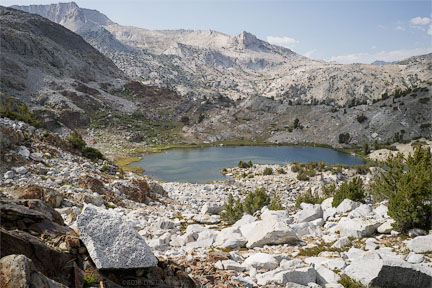EXCERPT page containing first few paragraphs. 2024-04-18 00:19:48
UA_SEARCH_BOT_null @ 18.191.195.110
For full access, subscribe here. Or click title to login. ![]()
Example: Two-Frame Stack (Spuller Lake, Zeiss Loxia 35/2)
The composition benefits from having everything sharp near to far, but without focus stacking there would be no way to render the foreground gneiss erratic sharply, even at f/16, and that would degrade the entire image too much.
Zerene Stacker PMAX mode delivered a ready to use image with the command. No obvious stacking artifacts are found, though there is a blurry area just behind and to the left of the foreground gneiss boulder: a 3rd frame would have been helpful.
The lingering slightly blur in the extreme bottom left is a lens weakness (the near-focus frame was on the white gneiss erratic near lower left).
Article continues for subscribers...
Diglloyd Making Sharp Images is by yearly subscription. Subscribe now for about 13 cents a day ($50/year).
BEST DEAL: get full access to ALL 8 PUBLICATIONS for only about 75 cents a day!
Diglloyd Making Sharp Images articulates years of best practices and how-to, painstakingly learned over a decade of camera and lens evaluation.
Save yourself those years of trial and error by jump-starting your photographic technical execution when making the image. The best lens or camera is handicapped if the photographer fails to master perfect shot discipline. High-resolution digital cameras are unforgiving of errors, at least if one wants the best possible results.
- Eases into photographic challenges with an introductory section.
- Covers aspects of digital sensor technology that relate to getting the best image quality.
- Technique section discusses every aspect of making a sharp image handheld or on a tripod.
- Depth of field and how to bypass depth of field limitations via focus stacking.
- Optical aberrations: what they are, what they look like, and what to do about them.
- MTF, field curvature, focus shift: insight into the limitations of lab tests and why imaging performance is far more complex than it appears.
- Optical aberrations: what they are, what they look like, and what to do about them.
- How to test a lens for a “bad sample”.
Intrigued? See Focusing Zeiss DSLR Lenses For Peak Performance, PART ONE: The Challenges, or (one topic of many) field curvature.

Focus-stacked image, 2 frames
Sony A7R II + Zeiss Loxia 35mm f/2 Biogon
[low-res image for bot]

